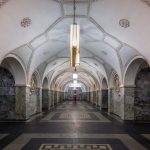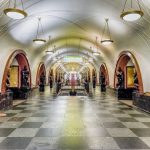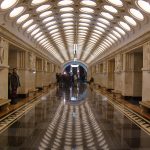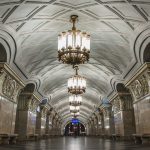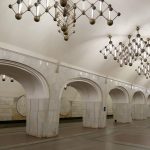Legions of football fans have packed their passports, slipped on their nation’s football shirt and, equipped with bags of optimism, travelled thousands of miles in the hope of glory at the 2018 World Cup.
From Yekaterinburg in the east to Kaliningrad in the west and many metropolises in-between, this year the vast lands of Russia play host to the tournament across 11 of its major cities. In six of these cities, underground metros will transport football fans to and from games but there’s one in particular that’s been leaving tourists in awe: the Moscow Metro.
“Magnificent.” “Visually breath-taking.” “Smooth and efficient.” Aside from the odd headache navigating the sprawling network’s stations, concourses and tunnels, football fans are near unanimous with their praise for the Russian capital’s rapid transit system.
Just like the city’s eight-lane highways above, the Metro is designed to carry large numbers of people. In contrast to London Underground where platforms have few entrance passages, the Metro’s platforms are connected to a central hall through continuous series of arches.

The birth of the Metro
Construction of the city’s underground arteries began in 1930, years after metros had popped up in major cities across Europe, as well as in Japan, the United States and even Argentina. Eventually operations would begin in the Russian city in 1935. Not that the lateness of Moscow’s has impeded its growth. Modern day Muscovites now enjoy one of the largest metro systems in the world in terms of kilometres in length and stations. With a daily ridership of around seven million, it is the busiest mass transit system in Europe. This is more than twice the number carried by London Underground, which has 270 stations compared with the Moscow Metro’s 163.
During the early years of construction, the project carried the ambitious socialist tagline of “building a palace for the people”, unsurprising when you realise the work took place when Russia was led by Community party chief Joseph Stalin. The word ‘palace’ might have seemed an ambitious vision for a system that’s designed to get passengers from A to B but it is one the Moscow Metro lives up to.
Architectural masterpieces
With stained glass windows set in marble walls, ornate vaulted ceilings and chandeliers hanging from above, the Moscow Metro oozes luxury.
Many stations are viewed as architectural masterpieces, including Mayakovskaya station, one of the most magnificent which received international recognition in 1939 when its design scooped the Grand Prize at the World’s Fair in New York. In the stations of the Circle line – one of 13 lines – there are examples of iconic Soviet art. Built in the post-World War II era, all 12 stations were designed with sculptures, murals and original lighting, and every one of them is unique. Elsewhere, situated under Revolution Square on the Arbatsko–Pokrovskaya line, Ploshchad Revolyutsii station features 76 bronze statues – more than any other.

However, many other stations have been constructed over the years without the same grandeur in mind. In 1955, the government put a stop to the luxurious designs and a simple style endured until the 1970s when glass and “centipede” stations (that is those with 40 columns in two lines) were built. Designs have been modernised further ever since.
It’s no wonder a journey on the network has been described as an art and history tour of the nation, the metro is a tourist attraction in its own right – particularly for rail enthusiasts. Moscow is so proud of its underground system that it organised 72 guided tours for foreigners before the 2018 World Cup kicked off.

Like this story? Follow us on Facebook to keep up to date with rail industry news
But it’s not all style over substance, as the Moscow Metro has shown so far during the 2018 World Cup. Football fans have been able to travel for free on the network by flashing their match tickets, all metro maps and signs include English translations and, if passengers have been unable to get to a match, they’ve been able to enjoy a totally different atmosphere by watching fixtures live on-board trains.

Qatar 2022
Its national football team may not be competing but Qatar, the scheduled host of the 2022 World Cup, will have a keen interest in the performance of the Moscow Metro during the 2018 tournament. As many are left scratching their heads as to which nation will emerge as champions in the current competition, one of the tournament’s great triumphants looks to have been revealed already.
Although Qatar is building its own underground metro system from scratch for its capital Doha, much of the work is already complete ahead of operations beginning in 2020. Nevertheless, designers, engineers and planners will no doubt be looking to see what lessons can be learnt ready for Qatar’s big day when the world’s gaze turns to the brand-new metro system on the coast of the Persian Gulf.
Read more: Russian Railways organises free transport for World Cup football fans



